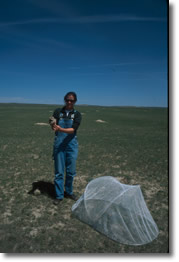Comparison of survey methods and effects of habitat features on reproductive success of Burrowing Owls in Wyoming
Western Burrowing Owl populations are thought to have declined in many portions of their breeding range. However, reliable survey data with which to accurately estimate population trends are not available. A continent-wide monitoring effort for Burrowing Owls has been proposed but survey methods that produce the most rigorous data for estimating population trends are not known. The goal of this project was to compare several potential survey methods to determine which will provide the highest detection probability and lowest observer bias. We compared detection probability and observer bias among driving surveys, roadside point counts, and walking transect surveys in eastern Wyoming. Walking transect surveys were time intensive and not productive; observers located no new nesting burrows using this method. Driving surveys produced the highest number of nests detected per unit time, but roadside point-count surveys produced the highest number of nests detected per unit area.


- Conway, C. J., V. Garcia, M. D. Smith, and K. Hughes. 2008. Factors affecting detection of burrowing owl nests during standardized surveys. Journal of Wildlife Management 72 (3):in press.